Prepare thoroughly for the UPSC Prelims with topic-wise questions in Physics, focusing on Mechanics. Enhance your understanding of fundamental principles and concepts in Physics through targeted practice. These questions are curated to cover a wide array of topics within Mechanics, aiding in a comprehensive review of the subject. From classical mechanics to modern physics, delve into the intricacies of motion, forces, energy, and more. Strengthen your grasp on key topics while honing your problem-solving skills. Whether you’re an aspiring civil servant or a student aiming for excellence in Physics, these UPSC Prelims topic-wise questions offer valuable insights and practice. Elevate your preparation and boost your confidence for the UPSC Prelims examination with this focused resource on Mechanics.
Contents
- 1 Q1. A parachutist jumps from a height of 5000 m. The relationship between his falling speed v and the distance fallen through d is best represented as (1995)
- 2 Q2. The variation of displacement d with time t in the case of a particle falling freely under gravity from rest is correctly shown in (1996)
- 3 Q3. Distance-time graph in respect of a race among four persons is shown in the given figure. Consider the following statements in this regard (1996)
- 4 Q4. A simple machine helps a person in doing (1996)
- 5 Q5. When an air bubble at the bottom of lake rises to the top, it will (1996)
- 6 Q6. A liquid is flowing in a streamlined manner through a cylindrical pipe. Along a section containing the axis of the pipe, the flow profile will be not similar and will look like (1996)
- 7 Q7. Which one of the following is a vector quantity? (1997)
- 8 Q8. A smooth inclined at an angle θ with the horizontal shown in the figure. A body starts from rest and slide down the inclined surface. The time taken by the body to reach the bottom is (1997)
- 9 Q9. A car is running on a road at a uniform speed of 60 km/h. (2004)
- 10 Q10. A spherical body moves with a uniform angular velocity (w) around a circular path of radius(r). (2004)
- 11 Q11. A weightless rubber balloon is filled with 200 cc of water. Its weight in water is equal to (2004)
- 12 Q12. Four wires of same material and of dimensions a mentioned below are stretched by a load of same magnitude separately. Which one of them will be elongated maximum? (2007)
- 13 Q13. Three identical vessels A, B and C are filled with water, mercury and kerosene respectively upto an equal height. The three vessels are provided with identical taps at the bottom of the vessels. If the three taps are opened simultaneously, then which vessel is emptied first? (2007)
- 14 Q14. How can the height of a person who is 6 ft tall be expressed (approximately) in nanometre? (2008)
- 15 Ans. (c)
- 16 In case you still have your doubts, contact us on 9811333901.
Q1. A parachutist jumps from a height of 5000 m. The relationship between his falling speed v and the distance fallen through d is best represented as (1995)
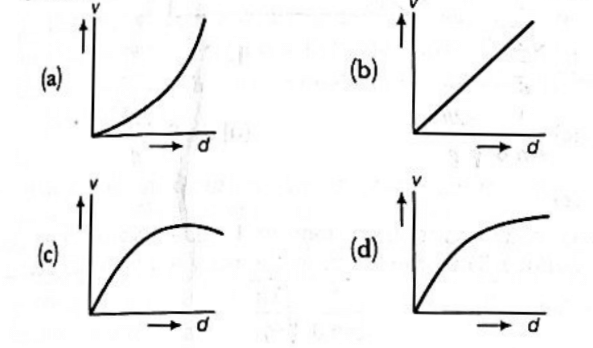
Ans. (d)
When a parachutist jumps from a height of 5000 m, the relationship between falling speed
𝑣 and distance fallen through 𝑑 is best represented by the graph given in option (d). Initially, the parachutist’s speed increases with distance fallen due to the acceleration from gravity. However, as the falling speed increases, air resistance (viscous drag) also increases. Eventually, the force of air resistance becomes equal to the weight of the parachutist (mg), resulting in a constant velocity. Graphs (a), (b), and (c) are incorrect: (a) shows speed increasing parabolically, (b) depicts speed constantly increasing with distance, and (c) illustrates speed increasing then decreasing with distance.
Q2. The variation of displacement d with time t in the case of a particle falling freely under gravity from rest is correctly shown in (1996)
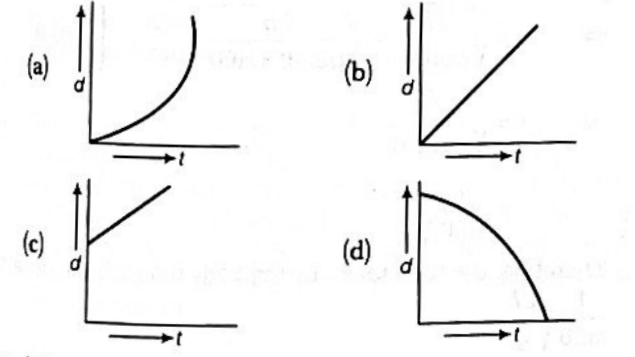
Ans. (a)
The correct representation of displacement 𝑑d with time 𝑡t for a particle falling freely under gravity from rest is shown in graph (a). According to the equation of motion, 𝑑=𝑢𝑡+1/2(𝑔𝑡2), where 𝑑 is displacement, 𝑢 is initial velocity, 𝑡 is time, and 𝑔 is acceleration due to gravity. Given that 𝑢=0, the equation simplifies to 𝑑=1/2(𝑔𝑡2), which is equivalent to a parabolic equation 𝑦=𝑎𝑥2. Graphs (b), (c), and (d) are incorrect as they depict linear relationships, indicating displacement decreasing with time.
Q3. Distance-time graph in respect of a race among four persons is shown in the given figure. Consider the following statements in this regard (1996)
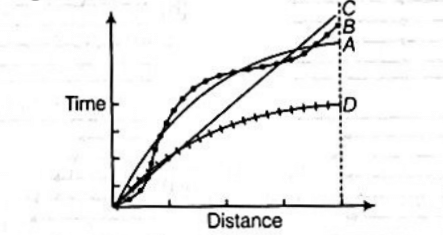
1. A stood first in the race
2. C leads all the way
3. Dran faster than others in the later part of the race
Of these statements
(a) 1 and 3 are false and 2 is true
(b) 1 and 2 are false and 3 is true
(c) 1 and 3 are true and 2 is false
(d) 1 is true and 2 and 3 are false
Ans. (b)
In the context of the distance-time graph provided for a race among four persons, statements (1) and (2) are false, while (3) is true. Analyzing the graph, A, B, C, and D represent the participants, with distance plotted along the X-axis and time along the Y-axis. D took the minimum time for the same distance covered, indicating D ran faster than others in the later part of the race or secured the first position. C, on the other hand, took the maximum time, implying C was the slowest. Thus, no participant led all the way. Therefore, option (b) is correct.
Q4. A simple machine helps a person in doing (1996)
(a) less work
(b) the same amount of work with lesser force
(c) the same amount of work slowly
(d) the same amount of work much faster
Ans. (b)
A simple machine is a mechanical tool that assists individuals in accomplishing tasks with less force while maintaining the same amount of work. For instance, utilizing a pulley enables us to raise heavier weights by exerting minimal force.
Q5. When an air bubble at the bottom of lake rises to the top, it will (1996)
(a) increase in size
(b) decrease in size
(c) maintain its size
(d) flatten into a dish like shape
Ans. (a)
When an air bubble situated at the lake’s bottom ascends to the surface, its size expands. This phenomenon occurs because the pressure of the liquid escalates with depth, while the air pressure within the bubble remains equivalent to the pressure of the surrounding liquid at any given depth. Consequently, as the bubble ascends, the liquid pressure diminishes, causing an increase in pressure inside the bubble. Consequently, the volume of the bubble enlarges, leading to its expansion.
Q6. A liquid is flowing in a streamlined manner through a cylindrical pipe. Along a section containing the axis of the pipe, the flow profile will be not similar and will look like (1996)

Ans. (d)
Within a segment containing the pipe’s axis, the flow pattern will exhibit dissimilarity and resemble the depiction provided in option (d). Streamline flow characterizes the movement of a liquid where each particle passing through a point follows an identical trajectory and velocity as the preceding particle traversing the same point. In a cylindrical pipe, the liquid’s velocity peaks at the center and gradually diminishes towards the walls. Conversely, the illustrations presented in options (a), (b), and (c) are inaccurate, depicting respectively static liquid, diverse layers flowing in varying directions, and disparate layers adhering to different patterns.
Q7. Which one of the following is a vector quantity? (1997)
(a) Momentum
(b) Pressure
(c) Energy
(d) Work
Ans. (a)
In a section containing the axis of the pipe, the flow pattern will differ and resemble the depiction given in option (d). Streamline flow describes the motion of a liquid where every particle passing through a point follows the same path and speed as the preceding particle at that point. Inside a cylindrical pipe, the liquid’s velocity is highest at the center and decreases progressively towards the walls. However, the diagrams in options (a), (b), and (c) are incorrect, showing a stationary liquid, layers flowing in different directions, and layers following various patterns, respectively.
Q8. A smooth inclined at an angle θ with the horizontal shown in the figure. A body starts from rest and slide down the inclined surface. The time taken by the body to reach the bottom is (1997)
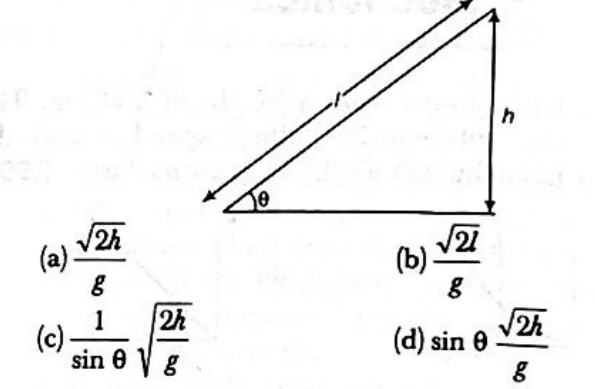
Ans. (c)
A body starts from rest and slides down the inclined surface. The time taken by the body to reach the bottom is

A smooth inclined plane in the given figure is at an angle θ with the horizontal. As the body is at rest its initial velocity u = 0. Now as the body slides down the inclined surface, the acceleration due to gravity g will be resolved into two components (as shown below) as gsinθ and gcosθ. Now, a = gsinθ is responsible for the body to slide down the inclined plane. Now, using the equation motion,
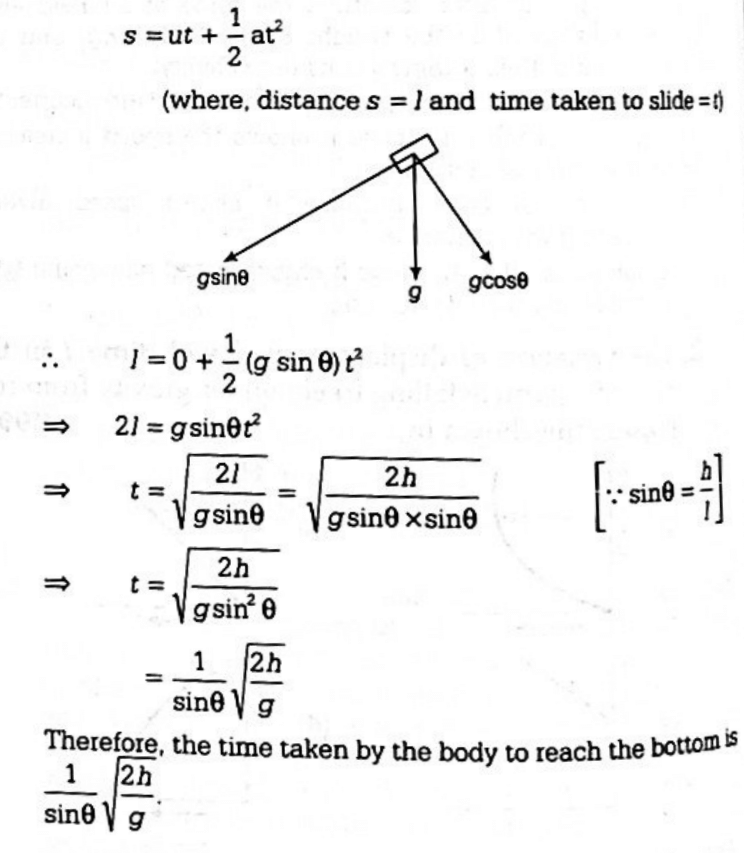
Q9. A car is running on a road at a uniform speed of 60 km/h. (2004)
The net resultant force on the car is
(a) driving force in the direction of car’s motion
(b) resistance force opposite to the direction of car’s motion
(c) an inclined force
(d) equal to zero
Ans. (d)
The overall force acting on a car moving at a steady pace on a road equals zero. This occurs because the velocity remains constant, meaning there’s no acceleration. Consequently, the total force (calculated as F=ma) exerted on the car is zero.
Q10. A spherical body moves with a uniform angular velocity (w) around a circular path of radius(r). (2004)
Which one of the following statements is correct?
(a) The body has no acceleration.
(b) The body has a radial acceleration w³r directed towards the centre of path.
(c) The body has a radial acceleration 2/5w³r directed away from the centre of the path.
(d) The body has an acceleration w² tangential to its path.
Ans. (b)
Statement (b) is accurate. When a spherical object moves with a consistent angular velocity (ω) along a circular trajectory, it experiences radial acceleration directed towards the center of the path. This can be illustrated by considering a particle traveling at a steady angular velocity (ω) along a circular path with a radius (r) and center at O, as depicted in the diagram.
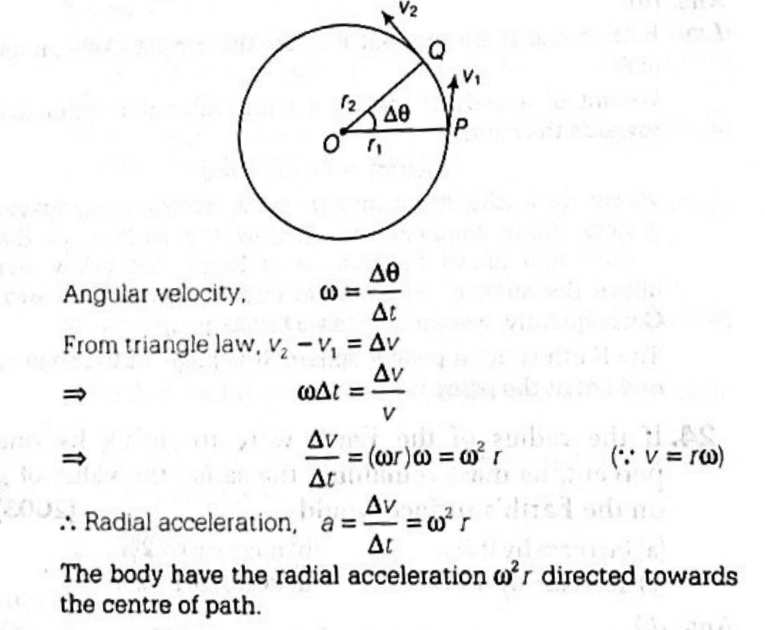
Q11. A weightless rubber balloon is filled with 200 cc of water. Its weight in water is equal to (2004)
(a) 9.8/5 N
(b) 9.8/10 N
(c) 9.8/2 N
(d) zero
Ans. (d)
The weight of a balloon filled with 200 cc of water and submerged in water becomes zero as it reaches a stable equilibrium. The downward force it exerts is counteracted by the upward buoyant force exerted by the water. Consequently, the net force acting on the balloon is zero.
Q12. Four wires of same material and of dimensions a mentioned below are stretched by a load of same magnitude separately. Which one of them will be elongated maximum? (2007)
(a) Wire of 1 m length and 2 mm diameter
(b) Wire of 2 m length and 2 mm diameter
(c) Wire of 3 m length and 1.5 mm diameter
(d) Wire of 1 m length and 1 mm diameter
Ans. (c)
The wire whose length is 3 m and diameter is 1.5 mm w be elongated maximum.

All wires made of the same material undergo stretching when subjected to a load of equal magnitude. Therefore, the Young’s modulus (Y) and the load (F) will remain constant for all wires.

Therefore, we can conclude that elongation is directly proportional to the length of the wire and inversely proportional to the square of its diameter. As a result, a wire with a length of 3 meters and a diameter of 1.5 mm will experience the maximum elongation.
Q13. Three identical vessels A, B and C are filled with water, mercury and kerosene respectively upto an equal height. The three vessels are provided with identical taps at the bottom of the vessels. If the three taps are opened simultaneously, then which vessel is emptied first? (2007)
(a) Vessel B
(b) All the vessels A, Band Cwill be emptied simultaneously
(c) Vessel A
(d) Vessel C
Ans. (d)
When all three taps are opened simultaneously, vessel C will be emptied first. This is because the viscosity of a fluid, which measures its resistance to gradual deformation by shear or tensile stress, determines its thickness. In ascending order of viscosity, the given materials are kerosene, water, and mercury. Thus, kerosene oil, having the lowest viscosity, will diffuse first and cause the vessel to empty. Water will diffuse second, followed by mercury, which has the highest viscosity among the three substances.
Q14. How can the height of a person who is 6 ft tall be expressed (approximately) in nanometre? (2008)
(a) 183×10° nm
(b) 234×10 nm
(c) 183×10² nm
(d) 234 ×10² nm
Ans. (c)
The height of a person who is 6 ft tall can be expressed approximately as 183 x 10^7 nm.
Using the conversion:
1 ft = 30.479 cm = 0.30479 m
6 ft = 1.82874 m
= 183 x 10^2 m
= 183 x 10 x 10 nm
= 183 x 10^7 nm
In case you still have your doubts, contact us on 9811333901.
For UPSC Prelims Resources, Click here
For Daily Updates and Study Material:
Join our Telegram Channel – Edukemy for IAS
- 1. Learn through Videos – here
- 2. Be Exam Ready by Practicing Daily MCQs – here
- 3. Daily Newsletter – Get all your Current Affairs Covered – here
- 4. Mains Answer Writing Practice – here

